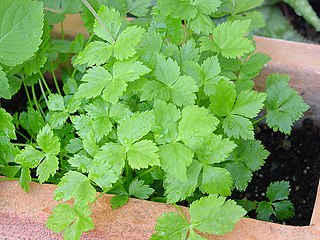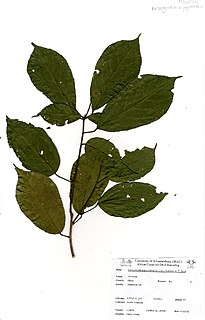
The Malvales are an order of flowering plants. As circumscribed by APG II-system, the order includes about 6000 species within 9 families. The order is placed in the eurosids II, which are part of the eudicots.

The term kola nut usually refers to the seeds of certain species of plant of the genus Cola, placed formerly in the cocoa family Sterculiaceae and now usually subsumed in the mallow family Malvaceae. These cola species are trees native to the tropical rainforests of Africa. Their caffeine-containing seeds are used as flavouring ingredients in beverages – whence the name ‘cola’, applied to various carbonated soft drinks, originates.

Tabernaemontana is a genus of flowering plants in the family Apocynaceae. It has a pan-tropical distribution, found in Asia, Africa, Australia, North America, South America, and a wide assortment of oceanic islands. These plants are evergreen shrubs and small trees growing to 1–15 m tall. The leaves are opposite, 3–25 cm long, with milky sap; hence it is one of the diverse plant genera commonly called "milkwood". The flowers are fragrant, white, 1–5 cm in diameter.

Sterculiaceae was a family of flowering plants based on the Genus Sterculia. Genera are now placed in the Family Malvaceae, in the subfamilies: Byttnerioideae, Dombeyoideae, Helicteroideae and Sterculioideae.

Cryptotaenia, or honewort, is a genus of herbaceous perennial plants, native to North America, Africa, and eastern Asia, growing wild in moist, shady places.
The wildlife of Gabon is composed of its flora and fauna. Gabon is a largely low-lying country with a warm, humid climate. Much of the country is still covered by tropical rainforest and there are also grasslands, savannas, large rivers and coastal lagoons.
Cola duparquetiana is a species of flowering plant in the family Malvaceae. It is found only in Gabon.
Cola letestui is a species of flowering plant in the family Malvaceae. It is found only in Gabon.
Cola lizae is a species of flowering plant in the family Malvaceae. It is found only in Gabon. It is threatened by habitat loss.
Dombeya amaniensis is a flowering plant species found only in Tanzania. Formerly placed in the family Sterculiaceae, this artificial assemblage is now included in the Malvaceae by most authors.

Heritiera utilis is a species of flowering plant in the family Malvaceae. It is found in Ivory Coast, Gabon, Ghana, Liberia, and Sierra Leone. It is threatened by habitat loss.

Nesogordonia papaverifera is a species of flowering plant. Traditionally included in the family Sterculiaceae, it is included in the expanded Malvaceae in the APG and most subsequent systematics.
Cardioglossa elegans is a species of frog in the family Arthroleptidae. It is found in southwestern Cameroon, Equatorial Guinea, and south to central Gabon. Common name elegant long-fingered frog has been coined for it.

The buff-spotted flufftail is a species of bird in the family Sarothruridae. It is found in Angola, Botswana, Burundi, Cameroon, Republic of the Congo, Democratic Republic of the Congo, Ivory Coast, Equatorial Guinea, Ethiopia, Gabon, Guinea, Kenya, Liberia, Malawi, Mozambique, Nigeria, Rwanda, Sierra Leone, Somalia, South Africa, South Sudan, Swaziland, Tanzania, Uganda, Zambia, and Zimbabwe.
Scaphopetalum is a genus previously classified under the plant family Sterculiaceae. Currently, under the APG IV system the genus is placed under the subfamily Byttnerioideae of the family Malvaceae senso lato. The distribution of the genus is restricted to the rain forests of Africa. In total 26 taxa have been described, 21 have been recognized, two invalid and one nomen nudus.

Sterculioideae is a subfamily of the family Malvaceae containing evergreen and deciduous trees and shrubs.

Cola is a genus of trees native to the tropical forests of Africa, classified in the family Malvaceae, subfamily Sterculioideae. Species in this genus are sometimes referred to as kola tree or kola nut for the caffeine-containing fruit produced by the trees that is often used as a flavoring ingredient in beverages. The genus is related to the South American genus Theobroma, or cocoa. They are evergreen trees, growing up to 20 m tall, with glossy ovoid leaves up to 30 cm long and star-shaped fruit.
Rhipidarctia invaria is a moth in the family Erebidae. It was described by Francis Walker in 1856. It is found in Angola, Cameroon, the Republic of the Congo, the Democratic Republic of the Congo, Gabon, Ivory Coast, Nigeria, Sierra Leone, Tanzania and Uganda.
C. elegans most commonly refers to the model round worm Caenorhabditis elegans. It may also refer to any of the species below. They are listed, first in taxonomic order and, second, alphabetically.
Catalina elegans is a species of rove beetles in the subfamily Aleocharinae. It has an Afrotropical distribution.









